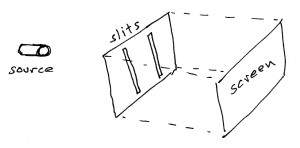![]() I want to describe a certain beautiful experiment, perhaps the most beautiful experiment in science. This is an experiment that has captivated me from the time that I first heard about it in high school. That’s because it’s simple to understand, and yet it captures the essence of what is truly messed up about quantum mechanics. This is a tale of two slits. And it would be no exaggeration to say that through these slits, we encounter a word that is so strange, it is beyond our human capacity to imagine.
I want to describe a certain beautiful experiment, perhaps the most beautiful experiment in science. This is an experiment that has captivated me from the time that I first heard about it in high school. That’s because it’s simple to understand, and yet it captures the essence of what is truly messed up about quantum mechanics. This is a tale of two slits. And it would be no exaggeration to say that through these slits, we encounter a word that is so strange, it is beyond our human capacity to imagine.
The story is about the nature of light and matter. And it is driven by a fervent battle of ideas between some of the greatest minds in science. It begins at the turn of the eighteenth century.
By then, Isaac Newton had already made a name for himself as the biggest badass in science. He invented calculus (edit: although the origins of calculus are somewhat mired in controversy), devised the law of gravity and formulated the laws that govern how things move. That’s pretty eventful for a few decades (in fact, he did much of this work in a single year), and it’s almost inhuman that all this came from a single person.
And things were just getting started. By the turn of the century, Newton had turned his considerable attention towards the problem of light. How does it work? What is it made of? Using a series of simple, methodical experiments, he argued that if you stripped light down to its tiniest constituents, you would end up with particles that he called corpuscles. This idea was widely adopted, and became the mainstream scientific opinion for over a hundred years.
There were always doubters to this idea, but they weren’t many of them, and they weren’t popular. It was another brilliant English scientist, Thomas Young, who would take the next step in understanding light.
Young was quite the Renaissance man. In addition to being a physicist, he made significant contributions to fields as diverse as music, language (he compared the vocabulary and grammar of 400 different languages), Egyptology (he partly deciphered Egyptian hieroglyphics from the Rosetta stone) and the physiology of vision.
But what Young considered his greatest achievement (and he had a few) was overthrowing Newton’s century-old notions of light. In its place, he argued that light was not made up of particles, but was instead a wave, quite like the ripples on the surface of water.
At first, he met with huge resistance to his ideas. But in 1803, Young convinced his skeptics with a simple, game-changing experiment.
Continue reading Why a quantum particle is not like a water drop. A tale of two slits, part 1
